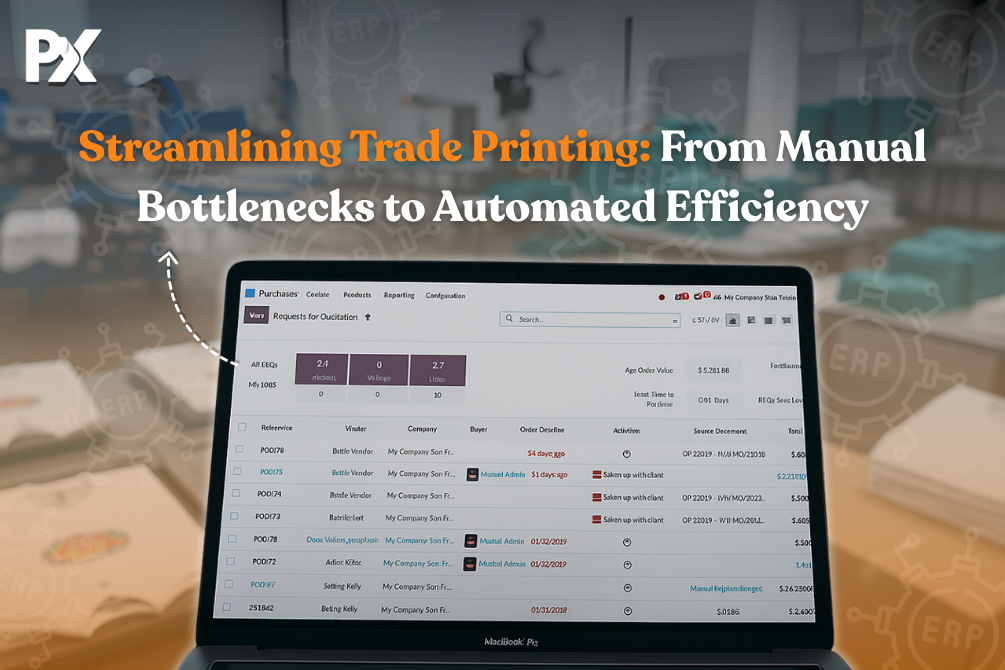- Summary
- Key Takeaways
- The Challenge: When Your Day Becomes a Game of Whack-A-Mole
- The Use Case: When One Order Becomes a Three-Ring Circus
- The Turning Point: When Technology Actually Solves Real Problems
- How the Trade Printer Workflow Works: From Catalogs to Multi-PO Automation
- Results: From Hours to Minutes—and No More Missed Opportunities!
- Professional Tip: Don't Automate Everything—Automate What Slows You Down
Summary
Every minute lost in procurement costs you momentum—and maybe the client!
You’re juggling your third RFQ of the day, two urgent POs sit half-complete in your inbox, and the customer’s asking for artwork approvals. Meanwhile, the corporate client who placed a rush order yesterday is already asking about delivery status.
If you’ve faced this or something similar, then this blog is just for you.
Wholesale trade printers, like you, have one of the toughest coordination jobs in the print industry. You’re the air traffic controller between customers who need custom solutions and the manufacturers and print houses that make stuff happen. Even today, most wholesale trade printing operations are still managing this circus with simple spreadsheets, email chains, and phone calls that create bottlenecks right when everything needs to move fast. But what if we tell you that there’s actually a way to automate that crazy purchase order workflow that runs your life?
Key Takeaways
- Quote Time Revolution: Drop from 2-3 hours per quote to under 5 minutes with automated pricing and product validation
- Error Elimination: Manual calculation mistakes that kill 20% of quotes get eliminated through automated print order management software
- Multi-PO Automation: Generate all three coordinated purchase orders (customer, manufacturer, print house) simultaneously after order approval
- Scalability Breakthrough: Handle 3-5x more orders with the same team size through purchase order workflow automation
- Competitive Advantage: Same-day RFQ responses while competitors take days, leading to higher win rates and better margins
The Challenge: When Your Day Becomes a Game of Whack-A-Mole
Have you ever noticed how RFQs always hit your desk at the worst possible moment? Like when you’re already juggling three urgent orders and trying to track down a supplier who’s gone radio silent?
Here’s what’s driving everyone crazy: each complex quote eats up 2-3 hours of your day. You’re digging through manufacturer catalogs that seem to update every time you blink, cross-referencing print house capabilities that vary by location, and trying to factor in delivery logistics that change based on order size and timeline.
Meanwhile, your competition, using print order management software, is firing back professional quotes in 20 minutes. And all of this is happening while you’re still hunting for the right product spec sheet.
Wondering how much time you’re losing to this manual madness? Our printing estimation tool might surprise you!
The error rate is what really gets you. Manual pricing calculations go sideways about 20% of the time. Sometimes you price yourself out of deals you should’ve won. Other times, you win jobs that barely break even after factoring in real costs.
But here’s the kicker. Every time you try to scale up, the chaos multiplies. More orders? More spreadsheets. More phone calls. More chances for things to slip through the cracks. And because of all of this, you end up hiring people just to manage the administrative nightmare instead of actually growing the business.
The Use Case: When One Order Becomes a Three-Ring Circus
Last month, we talked to a wholesale trade printer who landed what seemed like a straightforward corporate order for custom T-shirts and hoodies with full-color artwork. Nice order, decent margins, happy client.
Then reality hit!
Purchase Order #1 from the corporate client appeared straightforward—quantity, design specifications, delivery location, and timeline. Standard stuff that fits on one page.
But here’s where it gets fun (and by fun, we mean incredibly frustrating):
Purchase Order #2 had to be sent to the T-shirt and hoodie suppliers first since they couldn’t be shipped to the client. Why? Because they have to go directly to the print house for customization. So now the printer was coordinating delivery timing between two different vendors, making sure the T-shirts and hoodies arrived when the print house actually had capacity. That means they were managing two different shipping addresses and timelines, all at once.
Purchase Order #3 had to be sent to the print house with printing specifications that had to sync perfectly with the apparel delivery. Plus, the final shipment required white-label packaging and delivery to the client’s delivery address.
Three vendors. Three timelines. There are about seventeen different ways this could go sideways.
Getting tired of playing vendor coordination roulette every single day?
The trade printer spent six hours coordinating these three POs. Phone tag with the manufacturer about delivery timing. Email chains with the print house about artwork specs. Back-and-forth with the client about venue access. And you know what happened? The T-shirts and hoodies arrived two days late because the manufacturer and print house had differing ideas about “priority shipping.”
That’s the reality of wholesale trade printing: managing complex purchase order workflows, where a single miscommunication can derail the entire job.
The Turning Point: When Technology Actually Solves Real Problems
We have seen plenty of wholesale trade printers get burned by software that promised everything but delivered headaches. You know the drill—shiny demos that look great until you try using them for actual work.
PrintXpand is different because it gets the wholesale trade printing model at a fundamental level. Instead of trying to squeeze your workflows into some generic business software framework, it’s built around how trade printers actually operate.
Take quote generation, for instance. Most trade printer quoting software treats this like basic math—add up costs, slap on a margin, and send it out. But trade printing quotes aren’t just math problems. They’re coordination puzzles involving manufacturer capabilities, print house capacity, delivery logistics, and timing constraints that change based on twenty different variables.
PrintXpand’s solution handles this complexity without making you jump through hoops. Product specs pull automatically from current manufacturer databases. Pricing calculations factor in volume breaks, rush charges, and delivery options. The system generates professional proposals that break down every single cost component.
Want to see how this looks in practice?
But here’s where it gets really interesting: after client approval, the print order management system automatically generates all three coordinated POs simultaneously. Customer commitment locked through PO #1. Manufacturer fulfillment triggered through PO #2. Print house services initiated through PO #3. Everything is synchronized, tracked, and managed through a single dashboard, rather than three email threads and a prayer.
How the Trade Printer Workflow Works: From Catalogs to Multi-PO Automation
Let’s be honest about something! If you’re still managing wholesale trade printing operations with spreadsheets and email, you’re simply behind the curve, plus you’re playing a completely different game than your successful competitors.
The Catalog Reality Check
Remember those massive binders of product sheets that were outdated before you finished printing them? That’s so 2019. Modern print order management systems integrate directly with manufacturer and print house databases. When pricing changes (and pricing changes constantly these days), your system knows immediately. New products appear automatically. Capability updates happen in real-time.
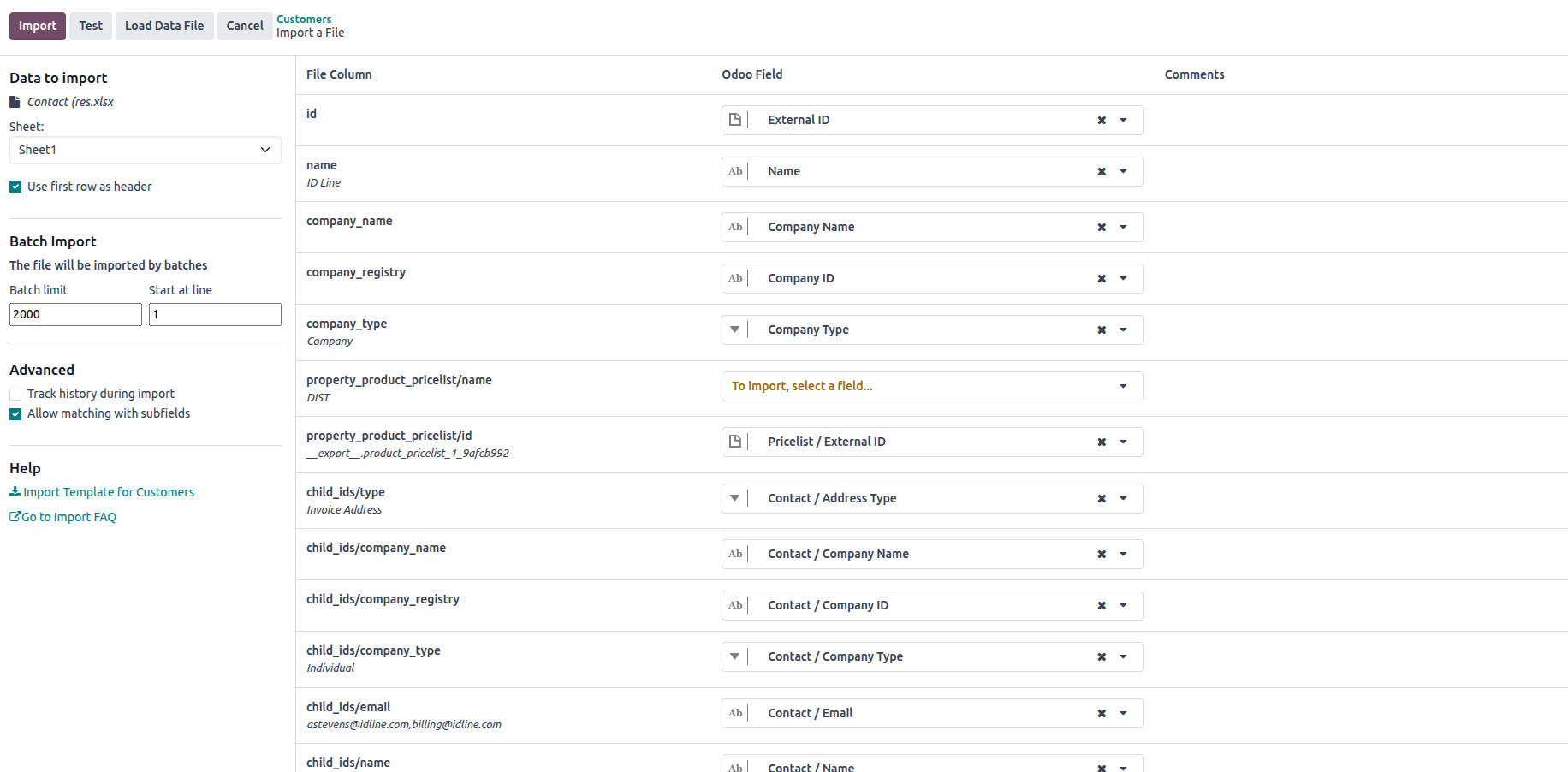
One operator told us this single change saved them 15 hours per month. That’s nearly two full workdays they got back to actually run their business instead of updating product information.
Business Rules That Don’t Require a PhD
Instead of trying to memorize every manufacturer’s minimum order quantities and every print house’s design limitations, you configure business rules once and let the system handle validation.
Try to quote a six-color process for a product that is limited to four colors? The system catches it before you embarrass yourself. Need rush pricing for a two-day turnaround when standard delivery is five days? The system applies correct charges automatically.
It’s basically like having that senior estimator who never takes vacation, never makes mistakes, and doesn’t need health insurance.
Customer Order Processing That Actually Works
When corporate clients place orders through a properly configured system, they experience operational sophistication that makes you appear to have your act together, even if you’re running lean.
Purchase Order #1 is generated with complete specifications and clear terms. Artwork proofing happens through the same platform. Status updates flow automatically. The client feels like they’re working with a major operation instead of someone managing everything from their Gmail inbox.
The system’s purchase order workflow automation ensures PO #1 contains all necessary details for downstream processing while maintaining flexibility to accommodate customer revisions during approval.
Multi-PO Magic That Actually Works
This is where the real transformation happens. After client approval, your purchase order workflow runs on autopilot:
PO #2 flows to your manufacturer with precise specifications, delivery timing, and shipping instructions. No phone calls. No email confirmation loops. The system incorporates manufacturer lead times, shipping logistics, and special handling requirements while maintaining perfect alignment with customer specifications.
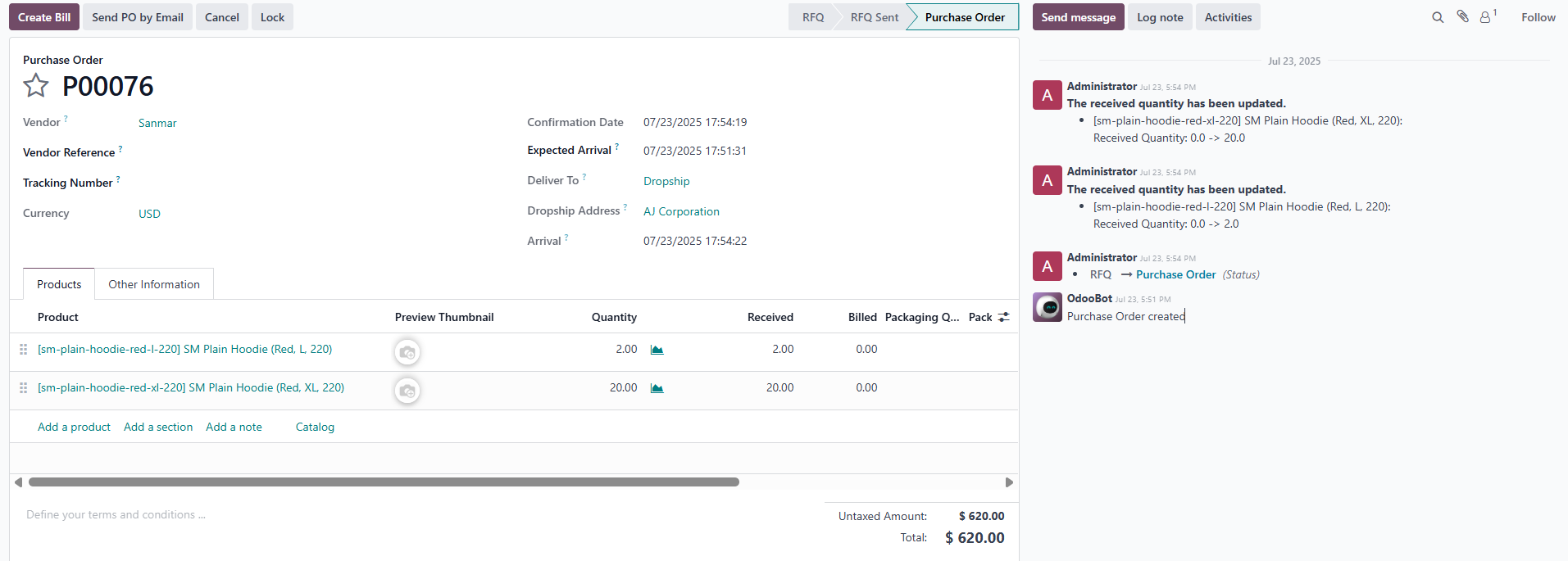
PO to SanMar (for Hoodies)
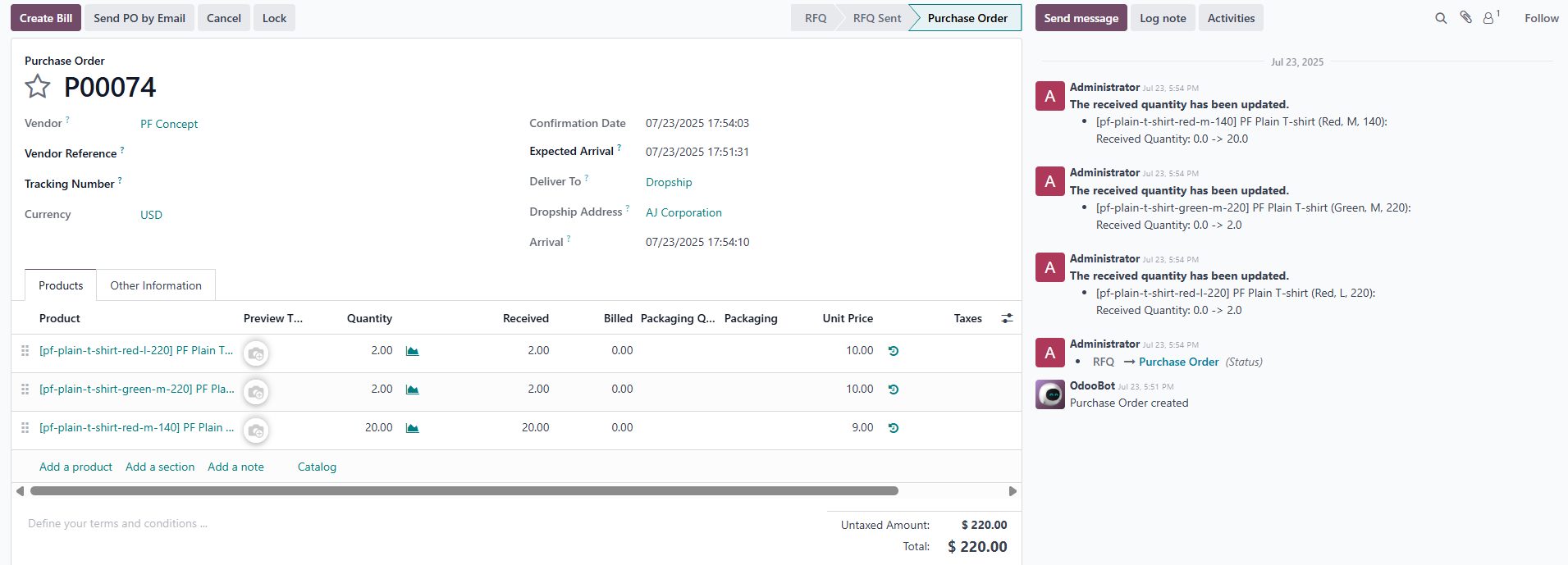
PO to PF Concept (for T-shirts)
PO #3 coordinates with your print house, synchronizing with material deliveries and including white-label requirements. This PO synchronizes with PO #2’s delivery timing while specifying quality standards and direct-to-customer fulfillment that maintains your brand relationship.
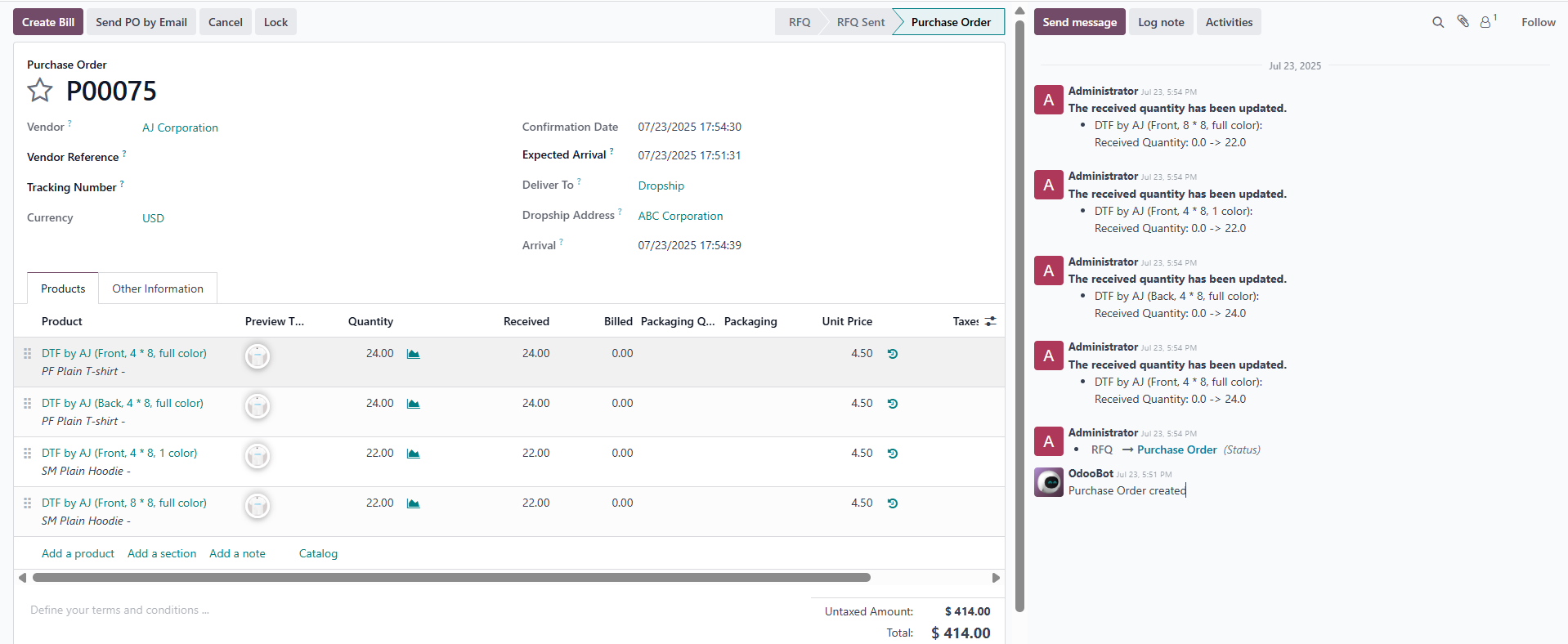
Ready to see this workflow eliminate your daily coordination headaches?
The automated coordination eliminates manual tracking, phone calls, and email chains that traditionally consume trade printing operations. Instead of juggling multiple vendor relationships manually, you can monitor the entire purchase order workflow through a unified dashboard that offers real-time status updates and proactive issue alerts.
End-to-End Visibility and Control
PrintXpand’s comprehensive print supply chain management solution gives wholesale trade printers complete operational transparency without requiring any physical production facilities. You maintain full control over customer relationships, quality standards, and delivery commitments while leveraging specialized manufacturer and print house capabilities.
This orchestration model enables trade printers to offer expanded product catalogs, faster turnaround times, and more competitive pricing than possible with traditional manual coordination methods. The result is a scalable business model that grows profitability along with the order volume.
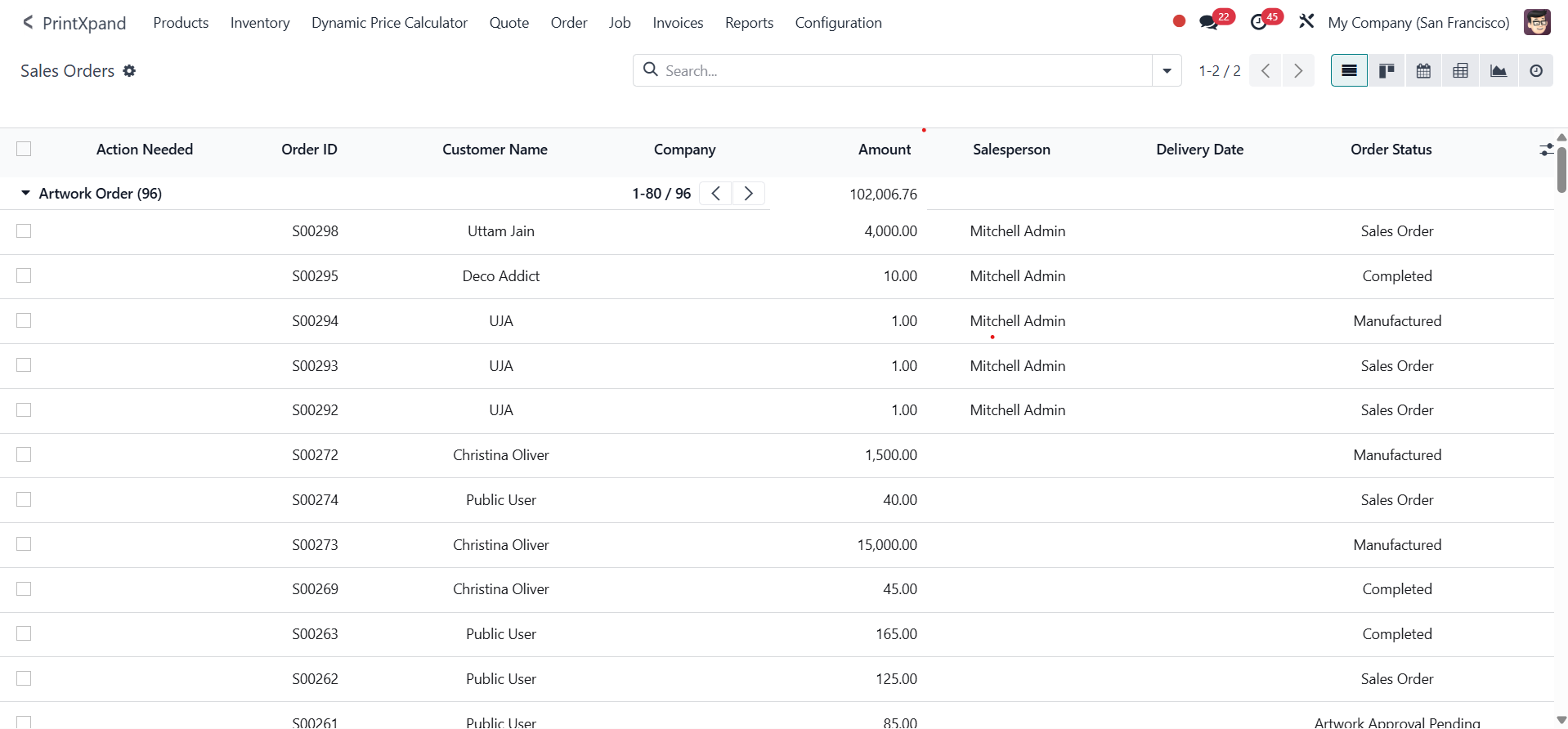
We’ve worked with operations that went from handling 200 orders per month (while everyone worked 50+ hour weeks) to smoothly processing 600+ orders with the same core team. In our experience, the difference isn’t working harder, but it’s working with systems that actually understand the wholesale trade printing business model.
Results: From Hours to Minutes—and No More Missed Opportunities!
Here are numbers from wholesale trade printers who made the switch—real operations, not hypothetical case studies.
A trade printer in Phoenix was spending 2.5 hours on complex quotes. After implementing proper print order management software, their average quote time dropped to 8 minutes. Their RFQ response rate jumped from 65% to 92% because they could respond the same day instead of saying “by next week.”
Another shop in Seattle was losing approximately $25,000 annually due to pricing calculation errors. After automation, their error rate dropped to essentially zero. Their margins improved 14% in the first year just from accurate pricing.
Curious what these improvements could look like for your operation?
A wholesale trade printer in Portland transformed from being overwhelmed while handling 180 orders per month to efficiently processing 650 orders per month. And these numbers tell the real story! With the same core team, they achieved better profitability per order because fixed costs were now spread across a larger volume.
In short, when you deliver instant quotes, proactive updates, and reliable delivery commitments, you stop being just another vendor. You become the partner your customer can’t afford to lose!
Professional Tip: Don't Automate Everything—Automate What Slows You Down
The most successful wholesale trade printers don’t try to automate everything. They automate the stuff, killing their productivity, and keep the human element for work that actually drives value.
Focus your print order management software on repetitive, time-consuming tasks, such as quote generation, purchase order workflow coordination, and status tracking. Maintain a personal touch for effective relationship building, creative problem-solving, and complex negotiations.
Your clients choose you because you understand their challenges and deliver results they can count on. Smart automation just makes sure you have time to be exceptional at what actually matters.
Ready to transform your trade printing operation from manual chaos to automated efficiency?
Instead of brawling with processes that functioned well at 100 orders per month but collapsed at 300, start building systems that scale alongside your business’s scale and success!
All product and company names are trademarks™, registered® or copyright© trademarks of their respective holders. Use of them does not imply any affiliation with or endorsement by them.
